Samurai Spirit
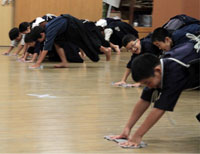
Everyone pitches in before practice, using rags to clean the dojo (training hall) floor.
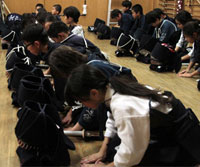
Kendo stresses proper manners and etiquette, beginning and ending with a bow.
The most important thing in kendo is to cultivate a strong mind and spirit. This can be seen among the youths who commute to dojo (training hall), never giving up as they practice barefoot on the frozen wooden floor in the midst of winter and in the sweltering heat of summer.
Before each practice, it is necessary to wipe clean the dojo floor and to bow and pay one’s respects to the kamidana, a small Shinto altar positioned to watch over practice in a dojo. Also, kendo practitioners always start and end their practices and matches with a firm bow to the opponent. Conducted without speaking, this bow is very important and if the timing is off, the match will not begin. Sportsmanship is also highly valued. For example, if a competitor pumps a fist in the air or celebrates in a flashy or improper way in a match after scoring a point, then the point can be taken away because this is viewed as disrespectful to the opponent.
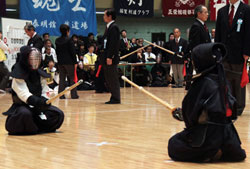
Kendo players squat facing each other, waiting silently for the match to start.
Many martial arts such as sumo, judo and karate from ancient Japan continue to flourish today. These arts share a mission to train one’s mind and body while mastering the art’s techniques and nurturing a tough spirit, thus cultivating oneself into a better person. Rooted and practiced in this very same spirit, kendo is more than a sport.
Kendo in Anime & Films
Kendo is also visible across Japanese culture, appearing in countless films, TV programs, manga and anime. One notable example is the popular manga titled “Bamboo Blade,” which was serialized as an anime. This is the story of a high school girls' kendo team that works hard to compete in national championships. It portrays everyday female students that are transformed into sharp, capable sword-wielding competitors when they step into a match. This comic also ignited interest in kendo among young people.
 |
 The popular manga comic “Bamboo Blade,” the story of female high school students who practice kendo. “BAMBOO BLADE”© Masahiro Totsuka/Aguri Igarashi/SQUARE ENIX
The popular manga comic “Bamboo Blade,” the story of female high school students who practice kendo. “BAMBOO BLADE”© Masahiro Totsuka/Aguri Igarashi/SQUARE ENIX
|
It is said that more people in Japan have tried kendo than judo, another well-known sport with roots in Japanese grappling martial arts. Nowadays, the number of kendo practitioners is increasing with the art becoming a subject that middle school students are required to practice.
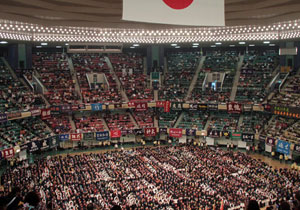
The opening ceremony of the National Youth Martial Arts Rensei Tournament. Nearly 5,000 competitors from around Japan take part in the two-day event, packing Nippon Budokan, hallowed ground when it comes to martial arts in Japan.
Today, as ever, Japanese children enjoy practicing kendo, keeping the tradition of the samurai spirit alive while engaging in healthy competition to train their minds and bodies.
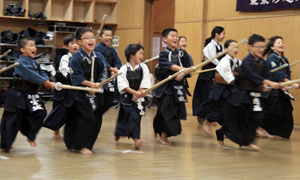
Children practice kendo at a town dojo
(Tokyo Shudokan).
(September 2012)